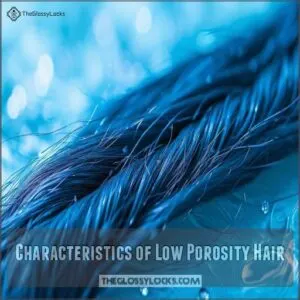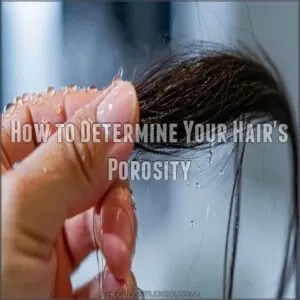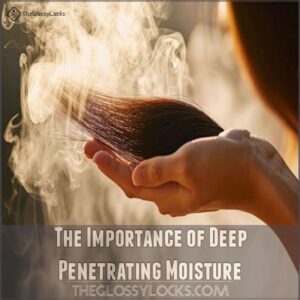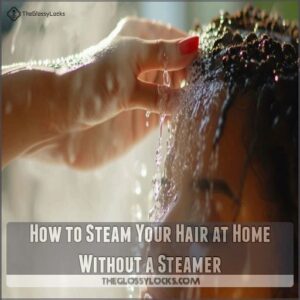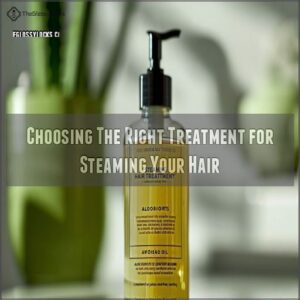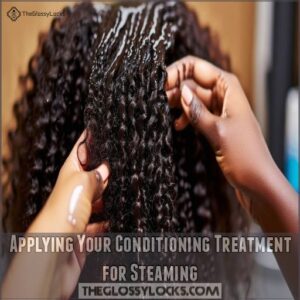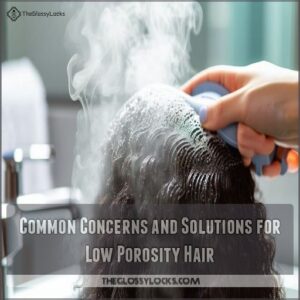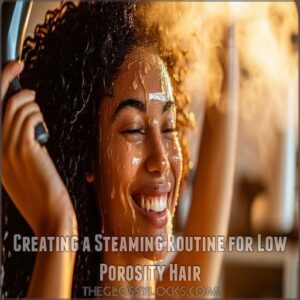This site is supported by our readers. We may earn a commission, at no cost to you, if you purchase through links.
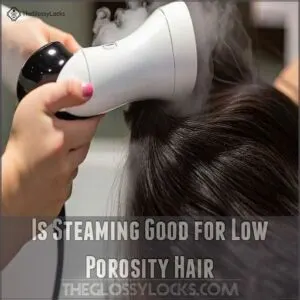 Is steaming good for low porosity hair? Absolutely!
Is steaming good for low porosity hair? Absolutely!
Think of it like opening a window to let in a fresh breeze.
Steaming gently raises your hair cuticles, helping moisture slide in like a welcome guest at a tea party.
It boosts blood flow to your scalp, potentially encouraging hair growth.
Low porosity hair often struggles to get hydrated, but steaming provides the golden ticket for moisture.
While heat caps and dryers are team players, steaming takes the spotlight for efficiency.
Curious about maximizing these benefits? Stay tuned, as the next tips could transform your hair care routine!
Table Of Contents
- Key Takeaways
- What is Low Porosity Hair
- Is Steaming Good for Low Porosity Hair
- The Importance of Deep Penetrating Moisture
- Steaming Techniques for Low Porosity Hair
- Common Concerns and Solutions for Low Porosity Hair
- Creating a Steaming Routine for Low Porosity Hair
- Frequently Asked Questions (FAQs)
- Is steaming good for low porosity hair?
- Which is better for one’s health, a steam room or a sauna?
- How do you steam low porosity hair?
- Which steamer is best for low-porosity hair?
- Are hair serums good for low porosity hair?
- Does steaming your hair help soften your hair?
- Should I steam low porosity hair?
- Which moisture method is best for low porosity hair?
- Is heat good for low porosity hair?
- What is not good for low porosity hair?
- How often should I steam low porosity hair?
- Can steaming damage low porosity hair?
- What oils are best for steaming?
- Does steam affect hair color treatments?
- Should I condition hair after steaming?
- Conclusion
Key Takeaways
- Steaming helps open up the cuticles of low porosity hair, allowing moisture to penetrate effectively and enhancing hydration and softness.
- Regular steaming boosts moisture retention, shine, and scalp health, turning your hair care routine into a revitalizing experience.
- Use steaming as a gentle, effective alternative to heat caps and dryers, with less risk of damage and frizz.
- Integrate lightweight oils like argan or sweet almond during steaming to enhance moisture absorption for softer, more manageable hair.
What is Low Porosity Hair
If you’ve noticed that your hair seems to repel water and takes forever to get wet in the shower, you might’ve low porosity hair, which means your hair’s outer layer has tightly packed scales that make it tough for moisture to get in.
Your hair’s porosity level isn’t a flaw but rather a natural characteristic that simply requires the right care approach to keep it healthy and hydrated.
Characteristics of Low Porosity Hair
Low porosity hair can be tricky to manage, but understanding its characteristics helps you take control. Your strands have tightly packed cuticles that make moisture absorption challenging.
Here’s what low porosity hair typically looks like:
- Takes forever to get wet in the shower
- Feels stiff and resistant to products
- Products tend to sit on top rather than absorb
- Often looks shiny when healthy
- Can appear dense and thick
How to Determine Your Hair’s Porosity
Understanding your hair’s porosity feels like solving a puzzle, but it’s simpler than you’d think. Knowing how your hair’s cuticle structure affects its ability to absorb and retain moisture, but it’s simpler than you’d think.
Watch how your hair reacts to water and products in your daily routine.
If your hair takes forever to get wet in the shower or leaves products sitting on top instead of absorbing them, you’re likely dealing with low porosity strands.
A quick texture analysis can reveal tight, overlapping cuticles.
Try The Sink or Float Test
Many hair experts recommend checking your hair’s porosity level by understanding its ability to absorb and retain moisture, which is significantly influenced by the hair cuticle structure. Many hair experts recommend the simple yet effective float test to check your hair’s porosity level.
It’s important to understand that low porosity hair can benefit from specific products designed to penetrate its tightly sealed layers.
You can find a wide range of low porosity hair products to help you achieve your desired hair goals.
Here’s how to do it:
- Take a clean glass and fill it with room temperature water
- Grab a few strands of clean, product-free hair
- Drop the strands into the water
- Watch for 2-4 minutes – if your hair floats, you’ve got low porosity hair; if it sinks, it’s high porosity
Test With a Spray Bottle
Before diving into complex tests, grab a spray bottle filled with water and mist a small section of clean, dry hair.
Watch how the water behaves – if droplets sit on top of your strands like morning dew on grass, you’ve likely got low porosity hair.
Low porosity hair‘s tightly bound cuticles often cause it to repel water, making it difficult for moisture to penetrate.
High porosity hair, on the other hand, will quickly absorb the water, leaving no visible beads behind.
Is Steaming Good for Low Porosity Hair
If you’ve ever felt like your low porosity hair just won’t drink up moisture, steaming might be your new best friend.
This technique opens up your hair cuticles, letting moisture in and bringing your hair back to life.
The Benefits of Steaming for Low Porosity Hair
Steaming transforms your hair routine by enhancing moisture retention, which can be especially beneficial for low porosity hair that needs help locking in hydration using a technique like the LOC method for sealing moisture in hair. Steaming transforms your hair routine by enhancing moisture retention, boosting shine, and promoting hair growth.
It’s like giving your hair a spa day—Pampering your scalp enhances scalp health, ensuring it feels less like a desert and more like a lush oasis.
Toss in some extra TLC with regular steam sessions, and watch as your locks become healthier and more vibrant.
How Steaming Helps With Moisture Absorption
Steaming’s like giving your hair a warm hug, coaxing those tight cuticles to let moisture in.
Feel the steam’s heat activation gently open up your hair’s cuticle layers, boosting moisture retention and product absorption.
Suddenly, your low porosity hair starts soaking up the good stuff.
It’s moisture magic, turning your hair from dry to dazzling in no time!
Steaming Vs Heat Caps and Dryers for Low Porosity Hair
So, you’ve learned how steaming boosts moisture. Now, let’s compare it to heat caps and dryers. Heat caps provide gentle, even warmth, while dryers offer more intense heat, potentially damaging hair. Steaming is a gentler approach.
- Imagine your hair drinking water, not being scalded!
- Steaming feels like a spa day, not a hair-raising experience.
- Say goodbye to frizz, hello to shine!
The Importance of Deep Penetrating Moisture
If you’ve ever watched water roll off low porosity hair like rain on a fancy car, you know moisture isn’t easy to absorb.
Deep penetrating moisture is essential to break through those tightly packed cuticles,
making products like steamers and rich conditioners your best friends for hydration.
Why Moisture is Crucial for Low Porosity Hair
Because low porosity hair often struggles to soak up moisture, keeping it hydrated is essential for maintaining healthy hair and preventing breakage.
This type of hair needs moisture to enhance its shine and luster, ultimately boosting hair strength.
By controlling frizz, you’ll find your hair looks smoother and feels silkier, making everyday hair care less of a hassle.
How to Lock in Moisture for Low Porosity Hair
You’ve learned how moisture impacts low porosity hair.
Now, let’s make sure it stays put!
Lock in moisture by applying hair masks or deep conditioning treatments under heat, especially for low porosity hair, which may benefit from gentle coaxing to absorb moisture effectively, as explained in hair porosity basics.
This helps seal cuticles, creating a barrier to retain hydration.
Try overnight treatments for extra absorption.
Embrace these moisturizing products, and you’ll have your hair thanking you in no time!
Using Emollient Ingredients for Low Porosity Hair
Think of emollient ingredients as your hair’s best friend, helping low porosity hair absorb and retain moisture with ease.
Opt for products featuring jojoba oil, shea butter, or avocado oil, which are great emollients.
These ingredients create a moisture-locking barrier, making hair care routine a breeze.
Enjoy smoother strands that feel soft, hydrated, and utterly manageable.
Steaming Techniques for Low Porosity Hair
Steaming your hair might sound like prepping for a fancy spa day, but you can actually do it from the comfort of your own home.
Steaming your hair can boost your hair’s hydration and make it easier to manage.
How to Steam Your Hair at Home Without a Steamer
So, you’ve locked in that moisture. Now, let’s steam! DIY hair steaming doesn’t need fancy tools. Here’s how to do it at home:
- Try the towel method: Wrap hot, wet towels around your hair.
- The shower steam works wonders. Let the steam do its thing.
- The plastic bag trick: Cover your hair with a plastic bag after conditioning.
- Need a heat cap alternative? A warm towel works just as well!
Choosing The Right Treatment for Steaming Your Hair
Picking the right treatment for steaming low porosity hair is key.
Consider investing in low porosity hair steam products for gentle hair care.
Aim for those with nourishing emollients like aloe, avocado, and jojoba oil.
These ingredients help during your steaming time by opening cuticles for better absorption.
Embrace a pre-steaming prep by ensuring your hair is clean, setting the stage for effective DIY steaming.
Plan a thoughtful aftercare routine post-steaming for best results.
Applying Your Conditioning Treatment for Steaming
You’ve got your perfect deep conditioner or leave-in ready.
Now, try sectioning your hair—it seems like organizing your pantry, doesn’t it?
Apply your product, making sure each strand gets attention.
It’s important pre-steaming prep!
Make sure every section is well-coated and ready for its steaming session.
With your conditioner choice set, you’re prepped for the best product application.
Common Concerns and Solutions for Low Porosity Hair
Dealing with low porosity hair can feel like you’re trying to hydrate a waterproof jacket, but don’t worry, there are simple solutions.
By choosing lightweight oils and avoiding heavy products, you can prevent build-up and keep your hair looking fresh and vibrant.
How to Prevent Build-Up on Low Porosity Hair
When steaming your low porosity hair, it’s key to combat product build-up.
Think of clarifying shampoos as your clean-up squad, sweeping away residue and grime.
Regularly assess your hair for build-up detection.
Stick to water-based products in your cleansing routine to keep hair happy without weighing it down.
Small tweaks in product choices can make a big difference.
Using Lightweight Oils for Low Porosity Hair
Struggling with product build-up? Lightweight oils are your hair’s best friend.
They slip right in, ensuring low porosity hair gets the moisture it craves without feeling weighed down.
Consider these top picks:
- Argan oil for shine
- Grapeseed oil for quick absorption
- Jojoba oil mimics natural oils
- Sweet almond oil is nourishing
- Baobab oil for strength
Avoiding Heavy Products for Low Porosity Hair
Some folks might think the heavier the product, the better. But with low porosity hair, lightweight products are your best bet. Products that are too rich can lead to product build-up, weighing your hair down. For instance, using a leave-in conditioning repair cream with deep-penetrating treatment, like Cantu’s Leave-In for Low Porosity Hair, requires careful application to prevent heaviness.
| Avoid | Embrace | Check |
|---|---|---|
| Heavy creams | Oils like jojoba | Ingredients list |
| Waxes | Lightweight serums | Hair density |
| Silicones | Water-based leave-ins | Product ingredients |
Creating a Steaming Routine for Low Porosity Hair
Now that you understand the benefits, let’s create a personalized steaming schedule that works for your hair.
Consistency is key, so find a routine you can stick with—even if it’s just once a month—to see real improvements in your hair’s health and hydration.
How Often to Steam Low Porosity Hair
Thinking about your steaming frequency for low porosity hair? Experts suggest a balanced approach.
Here’s a quick guide:
- Weekly Treat: Steam once a week for the best moisture.
- Monitor and Adjust: Pay attention to how your hair responds—less is more if needed.
- Avoid Over-steaming: Too much steaming can lead to unwanted dryness.
This ideal steaming schedule helps keep your hair healthy and hydrated!
The Right Timing for Steaming Your Hair
Finding the right timing for steaming your low porosity hair can feel like a quest for hidden treasure.
Since low porosity hair struggles with moisture absorption, especially in humid environments where humidity levels can cause frizz, pre-wash steaming can open up your hair’s cuticles, making room for moisture.
Post-wash steaming can also be beneficial in sealing moisture.
Keep each session around 10-15 minutes—no need to sweat it out like a long sauna visit!
Tips for Maintaining Healthy Low Porosity Hair
Keeping your hair healthy and strong is like nurturing a garden; it needs regular attention and the right tools.
Consider incorporating a steam hair treatment routine, which can be done with the right steam treatment products.
When working with low porosity hair, start with a solid foundation of detangling in the shower with damp hair, applying a detangling product like a leave-in conditioner. Embrace detangling techniques that gently work through knots without causing hair breakage.
Treat your scalp with care and consider hair masks rich in moisture.
Product recommendations can guide you, helping to maintain that perfect balance for low porosity hair.
Frequently Asked Questions (FAQs)
Is steaming good for low porosity hair?
Is your hair feeling dry and stubborn?
Steaming can work wonders for low porosity hair, opening those tight cuticles to let moisture in.
Just like a spa day for your hair, it enhances hydration and softness.
Which is better for one’s health, a steam room or a sauna?
Steam rooms offer gentler heat, better for sensitive skin. Saunas pack a hotter punch, potentially boosting circulation. Your choice depends on your preference and health goals.
How do you steam low porosity hair?
To steam low porosity hair, apply a hydrating conditioner, cover your head with a shower cap, and use a steamer or hot towel wrap.
This heat opens cuticles, allowing moisture and nutrients to penetrate effectively.
Which steamer is best for low-porosity hair?
For low-porosity hair, try a budget-friendly handheld steamer or the Q-Redew Hair Steamer.
Both options open up tightly packed cuticles, helping your hair absorb moisture better.
You’ll notice smoother, more hydrated hair in no time!
Are hair serums good for low porosity hair?
Think of hair serums as the cherry on top for low porosity hair.
They’re lightweight and can smooth the cuticles without weighing them down.
Opt for water-based serums that offer hydration and lock-in moisture effectively.
Does steaming your hair help soften your hair?
Steaming your hair softens it by opening the cuticle and letting moisture penetrate.
It’s like inviting a spa day for your strands, adding hydration and making them more manageable.
Just don’t overdo it—moderation is key!
Should I steam low porosity hair?
Your low porosity hair needs a little extra TLC, and steaming can be a game-changer.
It helps open up those tightly packed cuticle scales, allowing moisture to penetrate and hydrate your locks.
Which moisture method is best for low porosity hair?
Imagine this: your hair, a thirsty plant. For low porosity, gentle warmth opens cuticles; then, lightweight, water-based products seal in moisture. This is your best bet!
Is heat good for low porosity hair?
Yes, a little heat can work wonders for low porosity hair by opening up the tightly bound cuticles, letting moisturizing products penetrate more effectively.
Just think of it as opening up your hair’s potential for hydration!
What is not good for low porosity hair?
Remember battling stubborn, dull hair as you slather on heavy cream, hoping for shine?
Low porosity hair doesn’t like thick oils or greasy products.
They sit on top and cause buildup, making your hair feel lifeless.
How often should I steam low porosity hair?
Steam your low porosity hair once a week to improve moisture absorption without overloading it.
This regular ritual, like giving your hair a gentle hug, helps open the cuticles and lets treatments work wonders.
Can steaming damage low porosity hair?
Steaming low porosity hair won’t damage it if done moderately.
It can actually aid moisture absorption by opening the cuticles.
Just avoid doing it too often, or you might notice eventual dryness or brittleness.
What oils are best for steaming?
Using olive oil for hair can deeply nourish and repair hair due to its high penetration abilities, making it a great choice for pre-steaming treatments. Did you know that over 70% of people with low porosity hair benefit from steaming with oils?
Use lightweight oils like argan, grapeseed, or sweet almond to enhance moisture absorption, leaving your hair softer and more manageable.
Does steam affect hair color treatments?
Heat can fade your color, so steam treatments might slightly dull vibrant hues.
Think of it like sun-bleaching; consistent heat exposure can lighten your shade over time.
Protect your color with cool rinses afterward.
Should I condition hair after steaming?
You should definitely condition your hair after steaming.
The steam opens up hair cuticles, making it the perfect time to apply conditioner.
It’ll help lock in moisture, keeping your hair smooth and hydrated.
Conclusion
They say, "Don’t knock it ‘til you try it," and with hair steaming for low porosity hair, that’s spot on.
Steaming opens the cuticles, letting moisture in where it’s needed most, turning dry days into lush locks.
The process hydrates but also boosts circulation for potential growth.
Embrace steaming, explore its benefits, and enjoy revitalized, manageable hair.
Remember, steaming isn’t just good; it’s a game-changer for low porosity hair care.

